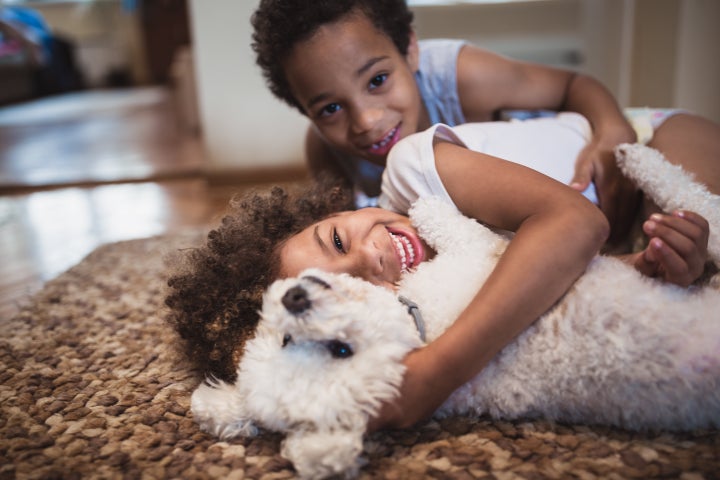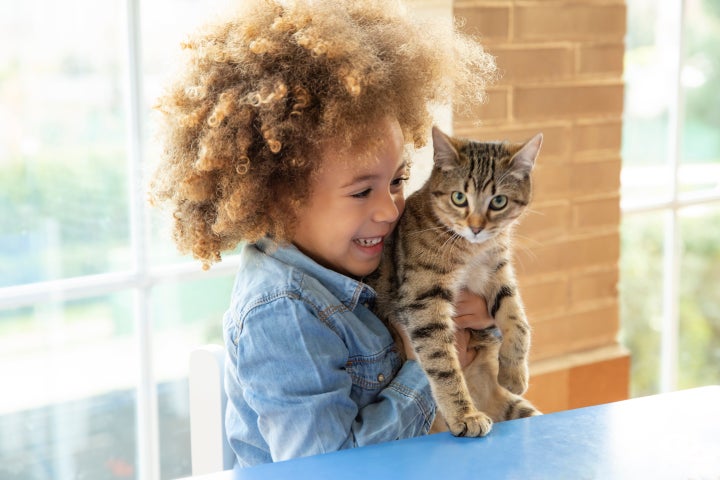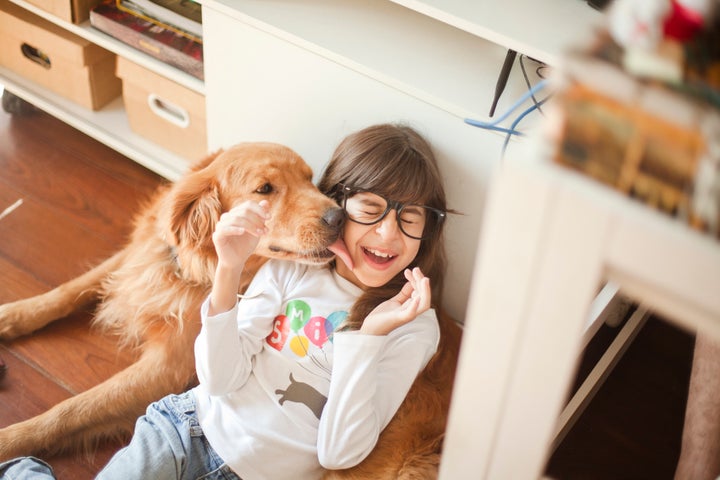
It doesn’t get much cuter than a photo of a baby with a dog ... or a cat ... or a bunny. But beyond the Instagram fodder, growing up with a pet can be very advantageous for a child.
“Pets play a huge part in our lives and can have a positive impact on a child’s mental and emotional health,” said Gina McDowell, a licensed professional clinical counselor and behavioral health clinical educator at the Big Lots Behavioral Health Pavilion at Nationwide Children’s Hospital in Columbus, Ohio.
Amid the COVID-19 pandemic, pet adoptions and sales have soared, so it’s clear many families have embraced animal companionship during this difficult time. But how exactly do pets benefit kids?
Below, McDowell and Steven Feldman, president of the Human Animal Bond Research Institute, break down some of the positive effects pet ownership can have on children’s mental health and development.
Improving Mood And Emotional Management
“Pets can help improve mood,” McDowell noted. “Playing with pets often creates positive emotions that can last throughout the day and may even help manage symptoms of anxiety and depression.”
Children, in particular, can enjoy great emotional benefits from spending time with animals during their formative years.
“One of the major reasons children find such comfort in the presence of pets is the non-judgmental presence that animals provide,” Feldman explained. “Studies have found that the mere presence of a family pet during childhood can increase emotional expression and control in children, and research supports that even brief interactions with dogs can lower stress levels in children.”
Feldman also highlighted a recently published HABRI-funded study led by the University of Western Australia and Telethon Kids Institute that demonstrated the benefits of family dogs for kids. Researchers collected survey data from more than 1,600 households and identified strong associations between dog ownership and improvements in well-being and social-emotional development in children.
“When compared to children in non-dog-owning households, children with a dog in the home were 23% less likely to have difficulties with their emotions and social interactions; 30% percent less likely to engage in antisocial behaviors; 40% percent less likely to have problems interacting with other children; and 34% percent more likely to engage in considerate behaviors, such as sharing,” Feldman explained.
The study also found that kids who walked the family dog at least weekly were 36% less likely to have poor social and emotional development than those who participated in dog walking less than once a week.
Creating A Helpful Sense Of Routine
Amid the disruptions of the pandemic, many families are still struggling to feel that sense of structure and routine that traditional schooling, office spaces and in-person activities provided. Pets can help fill that void by offering their own specific routines.
“Pets rely on us for eating, going on walks, and many other things,” McDowell noted. “We tend to develop a schedule when we have pets, and we know that having a set routine and structure helps children to thrive.”
To maximize the positive effects of pets, she advised allowing your child to be actively involved in their care.

“Having kids be a part of that routine and structure benefits both the child and their friend!” she said. “Additionally, allowing your child to participate in these tasks provides a sense of purpose and responsibility, improving feelings of self-worth.”
In addition to teaching valuable life skills, caring for pets often involves things like going for walks or otherwise moving around, which brings the benefit of increased physical exercise.
Offering Companionship And Comfort
It turns out the whole “boy’s best friend” trope is linked to real psychological advantages. Pets provide a powerful sense of companionship and comfort to kids.
“Studies show that pet owners experience less feelings of loneliness and increased sense of support,” McDowell explained. “Additionally, sensations such as touch can be very soothing, so extra cuddling with their furry, feathered, or scaly friend can provide children with a great coping skill.”
Feldman noted that pets can help reduce loneliness and isolation, feelings that are particularly prevalent in this time of social distancing. They can also help give kids the social confidence they need when they do return to more traditional interactive settings.
Companion animals like dogs, cats and rabbits have also been linked to improved social competence, interactions, and play behavior in kids ― as well as increased empathy and prosocial behavior.
“Pet horses and dogs have been found to increase social circles and the number of human contacts in children, which can increase emotional health outcomes such as self-esteem,” Feldman said.
To foster these positive benefits, parents can commit to spending more time together as a family with their children and pets.
“Schedule some family playtime with your pet throughout the day,” McDowell advised. “This could include playing with a special pet toy, going to a dog park or other outdoor adventures, or even taking time to teach your pet new tricks!”
Helping Kids With Autism
Having a pet at home or even at school can also help children with autism spectrum disorder who face unique challenges. Feldman pointed to a recent HABRI study about shelter cat adoption and the temperament of animals who may provide benefits for kids on the spectrum.
“The research found that children with autism experienced significant increases in the social skill of empathy, significant decreases in problem behaviors including bullying and hyperactivity/inattention, and also less separation anxiety after the introduction of a shelter cat,” he explained, noting that many participants showed increases and improvements in social behaviors like talking, making physical contact looking at faces and being more receptive to social advances from peers.

“The calmer, quieter demeanor of a cat could be suitable for children with autism, who commonly present with hypo and/or hyper-sensory issues, with over-reactivity to sound being identified most often,” Feldman added.
Other studies have found that pet dogs improved family functioning and decreased caregiver stress in families of children with autism, and that an animal-assisted activity program with guinea pigs in classrooms increased social functioning in kids on the spectrum.
Beyond Pet Ownership
Of course, not all families have the time or resources to bring a pet into the home. But there are other ways to foster positive interactions with animals.
“While pet ownership can be hugely beneficial to a child’s health and development, research also supports animal-assisted activities, such as animal-assisted therapy for children in certain settings,” Feldman said.
This includes children undergoing treatment for cancer and their families, who’ve found psychosocial benefits like reduced stress, improved communication and better emotional functioning due to regular visits from therapy dogs. Similarly positive results have been reported for kids and teens who received animal-assisted therapy to help cope with trauma.
Beyond therapy, families can also take advantage of volunteer opportunities involving animal care, go horseback riding, visit local farms, or even spend time at the homes of pet-owning loved ones.
Added Feldman, “Interaction with or taking care of a classroom pet such as a guinea pig or rabbit can confer similar social and behavioral benefits as interacting with or taking care of a family pet dog or cat.”
If you are considering welcoming a pet into your family, be sure to take time to determine the best course. Fostering a dog or cat on a temporary basis may be a great way to explore the possibility of pet ownership.
“Pets come in all shapes, forms, and sizes,” McDowell noted. “These benefits can apply to a pet of any kind. Take time to think about what type of pet would be the best fit for your family before making the decision to adopt a new friend. Finding that perfect pet can be the beginning of a wonderful adventure!”